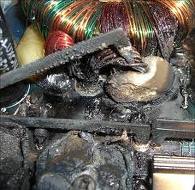Home Electromagnetic Waves Antenna Systems References
Reflection of electromagnetic energy back to transmitter components from an antenna is undesired.
A practical example of energy reflection:
Audio speakers can be compared to an antenna in that they transfer electrical energy into mechanical vibration energy. In turning up the volume of your high-powered sound system, there is a point at which the speakers will have absorbed their maxmium capacity for energy transfer. When this happens, the quality of the sound you hear may not be affected, but the sound system output components are receiving reflected energy back from the speakers. This reflected energy causes development of power levels in the output transistors that are higher than the transistors' ratings over a given time. This higher rate of work done will reduce the life of the components and may even cause immediate damage. The damage is apparent when the audio quality is distorted or fails to operate (sometimes the transistors will actually overheat and produce brief flame and smoke).

The situation described for an audio system applies to a transmitter and antenna system. The matching of impedance of the source (transmitter) and the load (antenna system and air combined) is critical to preventing reflection of power back to the transmitter and for maximum wave integrity. The transmitter components may develop higher power levels than those components are rated to handle and the transmitted electromagnetic wave may be degraded. A degraded output wave could have reduced or distorted energy, ultimately reducing the range and/or quality of the information contained in the transmitted energy.


(Clean Wave) (Distorted Wave)